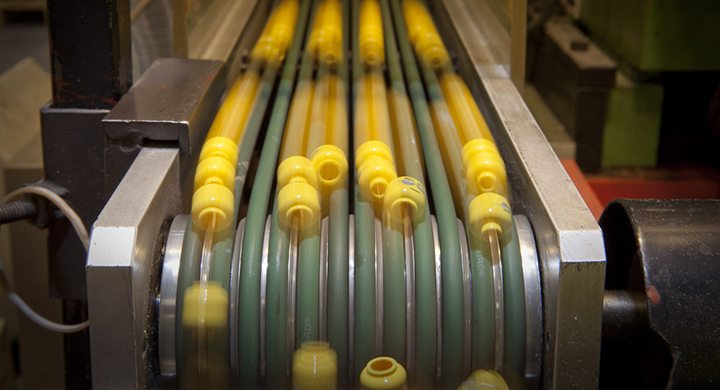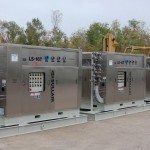Permanent Magnet Servo Motors
Permanent magnet servo motors are also known as brushless servo motors and/or PM (permanent magnet) servo motors. Permanent magnet servo motors are used when an industrial application requires high performance and precise speed regulation. Permanent magnet servo motors are manufactured with a designated controller known as a servo drive or servo driver. Permanent magnet servo motors use position feedback to precisely regulate motor control by being paired with an encoder. Encoders measure a brushless servo motor’soutput shaft position which is compared to the command position. When the servo motor output shaft doesn’t match the demand signal, an error signal is sent to the servo motor controller; the controller adjusts accordingly and sends a signal back to the servo motor until the demand position is met. PM servo controllers (servo drive, driver, etc.) are never included in the base price of the servo motor. Servo motor systems can be expensive but the cost is justified with optimal manufacturing processes via precise speed regulation.
Servo motors output more torque than brushed direct current motors. Brushless servo motors aren’t as loud during operation than brushed direct current servo motors. The lifespan of brushless servo motors exceeds than that of a brushed direct current motor because there aren’t brushes or a commutator to maintain. The idea behind brushless servo motors was to be able to integrate control function of the servo motor with industrial electronic components and personal computers; and to precisely position machines in manufacturing processes. Some manufacturers use brushless servo motors in explosive and dirty environments because brushless servo motors are entirely closed and sealed to prevent dust or sparks to reach the servo motor parts.
Permanent Magnet Servo Motor Design Process
 This process comprises threemain steps: Electromagnetic, structural and thermal designs. Electromagnetic design startswith magnetic circuit modeling and parameter optimization with a given set of designspecifications. A series of optimizations such as pole number, loading, current density,dimensional limits etc. have to be performed to find the optimum parameters of the motorbefore proceeding further. When a design is obtained that meets the technical spec, a quickmotor simulation and the influence of parameter variation must be carried out usingsimulation software such as SPEED (PC-BDC Manual, 2002). A detailed electromagneticfinite element analysis (FEA) either in 2D or 3D is the next step to verify that the designmeets the specified torque-speed characteristics and performance. After an electromagneticdesign is finalized, structural and thermal analyses (MotorCAD Manual 2004) have to becompleted. Structural analysis is not a necessity for design on low speed permanent magnet servo motors. If motor does not meet the structural or thermal tests, then theelectromagnetic design study should be repeated for a better design.
This process comprises threemain steps: Electromagnetic, structural and thermal designs. Electromagnetic design startswith magnetic circuit modeling and parameter optimization with a given set of designspecifications. A series of optimizations such as pole number, loading, current density,dimensional limits etc. have to be performed to find the optimum parameters of the motorbefore proceeding further. When a design is obtained that meets the technical spec, a quickmotor simulation and the influence of parameter variation must be carried out usingsimulation software such as SPEED (PC-BDC Manual, 2002). A detailed electromagneticfinite element analysis (FEA) either in 2D or 3D is the next step to verify that the designmeets the specified torque-speed characteristics and performance. After an electromagneticdesign is finalized, structural and thermal analyses (MotorCAD Manual 2004) have to becompleted. Structural analysis is not a necessity for design on low speed permanent magnet servo motors. If motor does not meet the structural or thermal tests, then theelectromagnetic design study should be repeated for a better design.
Permanent magnet servo motors are widely used in many industrial applications for theirsmall size, higher efficiency, noise-free operation, high speed range and better control. Thismakes quality of their torque an important issue in wide range of applications includingservo applications. For example, permanent magnet servo motors used in defense applications, robotics, servosystems, electric vehicles all require smooth torque operation.One of the most important issues in PM servo motors is the pulsating torque componentwhich is inherent in motor design. If a quality work is not completed during the designstage, this component can lead to mechanical vibrations, acoustic noise, shorter life anddrive system problems. In addition, if precautions are not taken, it can lead to seriouscontrol issues especially at low speeds. Minimization of the pulsating torque components isof great importance in the design of permanent magnet servo motors.In general, calculation of torque quality is a demanding task since the torque qualitycalculation does not only consider the torque density of the motor but also consider thepulsating torque component. Therefore, a mathematical approach about torque qualityshould include harmonic analysis of electric drive system rather than a simple sizing of the motor.
To learn more about permanent magnet servo motors or for servo motor repair and replacement quotes, contact Precision Electric, Inc.








